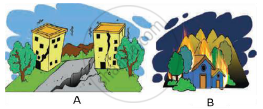Advertisements
Advertisements
प्रश्न
Write about disaster management cycle
उत्तर
The six disaster management phases that have been used in the concept of disaster cycle are as follows;
1. Pre-Disaster phase:
- Prevention and Mitigation:
- The term prevention is often used to embrace the wide diversity of measures to protect persons and property.
- Mitigation embraces all measures taken to reduce both the effects of the hazard itself and the vulnerable conditions to it in order to reduce the scale of a future disaster.
- Therefore, mitigation may incorporate addressing issues such as land ownership, tenancy rights, wealth distribution, implementation of earthquake-resistant building codes, etc.
- Preparedness:
- The process includes various measures that enable governments, communities and individuals to respond rapidly to disaster situations to cope with them effectively.
- Preparedness includes for example, the formulation of viable emergency plans, the development of warning systems, the maintenance of inventories, public awareness and education and the training of personnel.
- Early Warning:
- This is the process of monitoring the situation in communities or areas known to be vulnerable to slow onset hazards, and passing the knowledge of the pending hazard to people harmless way.
- To be effective, warnings must be related to mass education and training of the population who know what actions they must take when warned.
- The Disaster Impact:
- This refers to the “real-time event of a hazard occurrence and affecting elements at risk.
- The duration of the event will depend on the type of threat; ground shaking may only occur in a matter of seconds during an earthquake while flooding may take place over a longer sustained period.
2. During Disaster Phase:
- Response:
This refers to the first stage response to any calamity, which includes for examples such as setting up control rooms, putting the contingency plan in action, issue warning, action for evacuation, taking people to safer areas, rendering medical aid to the needy etc. simultaneously rendering relief to the homeless, food, drinking water, clothing etc. to the needy, restoration of communication, disbursement of assistance in cash or kind.
3. The Post- Disaster Phase:
- Recovery: Recovery is used to describe the activities that encompass the three overlapping phases of emergency relief, rehabilitation and reconstruction.
- Rehabilitation: Rehabilitation includes the provision of temporary public utilities and housing as interim measures to assist long-term recovery.
- Reconstruction: Reconstruction attempts to return communities with improved pre-disaster functioning. It includes replacement of buildings; infrastructure and lifeline facilities so that long-term development prospects are enhanced rather than reproducing the same conditions, which made an area or population vulnerable in the first place.
- Development: In an evolving economy, the development process is an ongoing activity. Long-term prevention/disaster reduction measures. For examples like construction of embankments against flooding, irrigation facilities as drought proofing measures, increasing plant cover to reduce the occurrences of landslides, etc.
APPEARS IN
संबंधित प्रश्न
Which aspects will you check for pre-disaster management in your school?
Observe the images ‘A’ & ‘B’ and answer the following questions.
i) Which disasters are shown in the images?
ii) Which primary precautions will you take in case of disaster shown in ‘A’?
iii) Which type of first-aid is offered to the injured peoples in disaster ‘B’?
Explain the role of district disaster control unit after occurrence of any disaster.
Answer the question.
Which are the objectives of disaster management?
What is the emergency contact number of the following?
Police Control Room
What is the emergency contact number of the following?
National-level single emergency number for disaster relief.
Suggest remedial measures for dealing with natural or man-made disasters.
| Disaster | Remedy | Disaster | Remedy |
| Fire | Earthquake | ||
| Building collapse | Deluge | ||
| Road accident | Storm | ||
| Flood | Tsunami | ||
| War | Drought | ||
| Bomb explosion | Landslide |
Write notes on Man-made disasters
Answer in detail:
Explain, with an example, how will you carry out disaster management in your region/ premises.
Give two examples of Post-disaster management.
